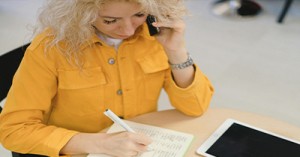Active Listening involves lending your undivided attention to someone who is speaking to you. As opposed to passive listening which is merely hearing the speaker without trying to understand what is being said, active listening leads to more effective communication, learning and problem-solving. The article provides information on What Active Listening Is, Active Listening Definition, Active Listening Skills Examples and more.
Active Listening Definition
Active listening is the practice of preparing to listen, observing what verbal and non-verbal messages are being sent, and then providing appropriate feedback for the sake of showing attentiveness to the message being presented.[1] This form of listening conveys a mutual understanding between speaker and listener. Speakers receive confirmation their point is coming across effectively, and listeners absorb more content and understanding by being engaged
Active Listening Skills and Active Listening Examples
Like with most life skills, the best way to foster active listening skills is to model it yourself. Here are a few strategies to practice active listening with your young learners.
Focus On The Speaker
When a child is saying something to you, give them your complete attention. Focus on what they are saying, both with their words as well as with voice inflections, rate of speech and body language. For example, when a child is explaining a picture they have drawn, observe their gestures and facial expressions as a clue for how interested they were in the task.
Respond Appropriately
Maintain eye contact with your speaker. Over time your learners will pick up the practice and reap its social benefits since people who maintain eye contact are seen as warm, trustworthy and approachable. Interact nonverbally with your learners using small gestures or verbal affirmations, such as nodding your head or offering very brief comments such as “I see”. Vocalizations such as “uh-uh” or “hmm-hmm” are other effective ways of showing that you are fully engaged in listening. However, avoid using exaggerated gestures or dramatic expressions which could confuse the speaker as to the import of their words or take away the focus from the speaker to the listener.
Be present
Try not to think about how you are going to respond as someone is speaking to you. This will cause you to lose your concentration on what the child has to say to you. Also do not interrupt or finish your speaker’s sentences. This takes the attention completely away from what the other person is saying and focuses it on your own words.
Reflect
Make sure you have understood what a child has been saying to you by repeating back the message in your own words. Such reflective strategies not only help in summarizing the essential points in a conversation but, if needed, allow the speaker a chance to correct you.
Ask Questions
Putting questions to your speaker is perhaps the most definitive sign that you have been listening actively. Use questions to probe for missing information or clarify any points that you might not completely understand. In fact, there are different types of questions suited for different purposes. For example:
- To expand a discussion further, you might ask an open-ended question like, ”How was your weekend?”
- To get specific inputs, close-ended questions are useful like “Are you done with the activity?”
- To expand and extend thinking, reflective questions are helpful like “What do you like best about having a pet?”
Foster Listening Skills
Finally, look for ways your learners can practise listening skills that you have modelled for them. These could be playing games such as Simon Says or Chinese Whispers in which players have to carefully listen for auditory cues. Again you might ask some prediction questions as you are reading a story or read two versions of the same story and then have learners pick out the differences. In general, the idea is to plan learning activities according to their interests so that children remain actively engaged, thereby honing their listening skills.







 As an Educator in Australia, your pay rate falls under the Children’s Services Award 2010. This award states the minimum amount that an employer can
As an Educator in Australia, your pay rate falls under the Children’s Services Award 2010. This award states the minimum amount that an employer can When working as a qualified Early Childhood Teacher (with a university degree) within a service, your rate of pay will come from the Educational Services
When working as a qualified Early Childhood Teacher (with a university degree) within a service, your rate of pay will come from the Educational Services When working as a Diploma Qualified Educator your pay rate is from the Children's Services Award 2010. This Award states your minimum rate of pay
When working as a Diploma Qualified Educator your pay rate is from the Children's Services Award 2010. This Award states your minimum rate of pay When working as a Cert 3 Qualified Educator, your pay rate is from the Children's Services Award 2010. This Award states your minimum rate of
When working as a Cert 3 Qualified Educator, your pay rate is from the Children's Services Award 2010. This Award states your minimum rate of Educational Leaders play a crucial role in their early childhood service by ensuring that the educational program aligns with best practices and supports the holistic
Educational Leaders play a crucial role in their early childhood service by ensuring that the educational program aligns with best practices and supports the holistic In early childhood education and care, ratios are more than a technicality—they are a frontline safeguard. Every child deserves responsive supervision, emotional connection, and developmental
In early childhood education and care, ratios are more than a technicality—they are a frontline safeguard. Every child deserves responsive supervision, emotional connection, and developmental With the new national child safety reforms kicking in on 1 September 2025, early childhood services like yours have a real opportunity to lead the
With the new national child safety reforms kicking in on 1 September 2025, early childhood services like yours have a real opportunity to lead the Here’s a comprehensive Mobile Phone and Smart Watch Policy tailored for early childhood education and care (ECEC) services in Australia, aligned with the latest 2025
Here’s a comprehensive Mobile Phone and Smart Watch Policy tailored for early childhood education and care (ECEC) services in Australia, aligned with the latest 2025 The Sea of Fish Challenge is a national initiative that invites children, educators, families, and communities to create and display fish artworks as a symbol
The Sea of Fish Challenge is a national initiative that invites children, educators, families, and communities to create and display fish artworks as a symbol Across the early childhood education and care sector, educators are sounding the alarm: current staffing ratios are insufficient to deliver safe, meaningful, and developmentally appropriate
Across the early childhood education and care sector, educators are sounding the alarm: current staffing ratios are insufficient to deliver safe, meaningful, and developmentally appropriate


